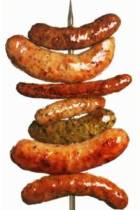Who said “I could put up with sausage and mash forever” – sorry, that should be Dr Who said etc., etc…well, in fact it was Colin Baker, the sixth actor to play the part.
Our word “sausage” comes from the old French “saussiche” which in turn comes from the Latin “salsus” meaning salted and for centuries sausages have been a way of preserving and presenting in a more acceptable and appetising form the blood, scraps and offal from butchered animals. It is thought the practice started over four thousand years ago in what is now Iraq. A goat and lamb variety was made in China in the sixth century BC and a century later the Greek playwright Epicharmus wrote a comedy called “The Sausage”. Later in the fourth century AD, Constantine, the first Christian Roman emperor forbade in eating of sausages because of their popular connection with the pagan festival of Lupercalia…shame.
Nowadays the sausage, either fresh or cured, can be found in most cultures; the wind-dried sausages of China and the Scots haggis; the paprika-rich and spicy merguez from North Africa and the mild veal weisswurst of Germany, South Africa’s boerewors and Cajun andouilles. It is a versatile thing, not necessarily made of meat, Glamorgan sausages are made with breadcrumbs, cheese and leeks and there are some wonderful seafood recipes. Some recipes for Cumberland sausage don’t even call for a skin, perhaps a blessing to home cooks who want to try their hands at sausage making without the bother of finding and filling encasings.
In New Zealand we probably consume more fresh sausages than other types such as salami, mortadella, etc although we do seem to have a strange attraction to some “exotics” like savaloys and cheerios, frankfurters and bier sticks; in recent years however our taste has been moving from the turgid deep-fried fish and chip shop “sossies” and their equally industrial relatives that lurk in the self-service hot cupboards in cafés, towards the more sophisticated and we are demanding more from our sausage makers than the mystery bags of old. Restaurants and pubs now take a pride in the humble banger, often giving its provenance on their menus, and where there was just “pork” or “beef” in all the supermarkets, there are now ranges of premium gourmet varieties, some supermarkets even taking prizes in the prestigious and hotly contested New Zealand Sausage Competition which is held annually.
But whether we do it on a barbecue or in the kitchen, sausages benefit from careful cooking. They are best if they retain all their juices so never prick them before or during cooking and cook them slowly so that they don’t burst, for with the weather getting colder of late, a plump sausage or two, garlicky mash, some fresh greens and a good mustard could be just what the doctor ordered but…if you are a vegetarian or just looking for a new sausage experience, try this recipe:
Glamorgan Sausages
150g leeks – trimmed, cleaned and finely chopped
20g butter
200g fresh white breadcrumbs
2 tbsp chopped parsley
1 tbsp chopped thyme leaves
150g finely grated cheese – originally Caerphilly but Cheddar style will do
½ tsp mustard powder
2 eggs
Salt and freshly ground black pepper
40g fresh white breadcrumbs – for coating
1 egg – beaten, for coating
Butter or oil for frying
Melt the butter in a frying pan, add the leeks and fry them gently without browning them, for about 8 minutes or until very soft.
Put the breadcrumbs, herbs and cheese in a bowl then add the leeks. Season well and mix thoroughly.
Add the mustard to the two eggs and beat well. Stir this into the bread mixture until well combined to form a firm dough. Should the mixture be too dry, add a little milk.
Divide the mixture into 8 or 12 portions and roll into sausage shapes. To coat, dip each sausage into the remaining egg then roll in the extra breadcrumbs. Put them on a tray lined with cling wrap and chill in the fridge for at least 30 minutes.
Heat a little butter or oil in a frying pan, non-stick is good, and then fry the sausages gently over a medium heat, turning regularly, until they are crisp and golden. Serve with a green salad or fresh green vegetables. Serves 4.










Join the Discussion
Type out your comment here:
You must be logged in to post a comment.